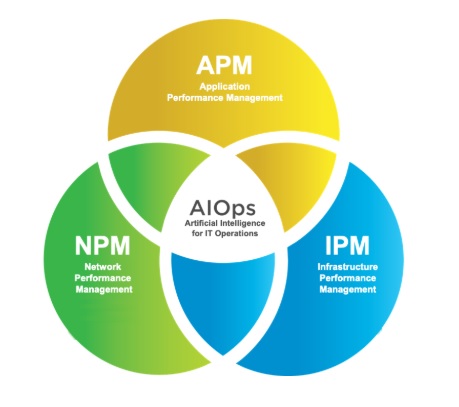
If you've followed the evolution of AI, you know that it has the potential to solve a myriad of problems across almost every industry. And if you've followed the evolution of AI-infused management tools aiming to address hybrid IT infrastructure issues, you know that a litany of these tools don't come close to providing a complete solution.
 Now comes AIOps — Artificial Intelligence for IT Operations — which takes aim at solving the complexity and scale of today's hybrid IT infrastructure. The premise of AIOps is to give IT Operations better control over how that infrastructure supports the business, and like the technologies that came before it, AIOps is geared for identifying the root causes of problems across multivendor environments and remedying issues. However, unlike the technologies that preceded it, the "AI" in "AIOps" hints at the added capability of being able to predict and resolve IT issues before they happen.
Now comes AIOps — Artificial Intelligence for IT Operations — which takes aim at solving the complexity and scale of today's hybrid IT infrastructure. The premise of AIOps is to give IT Operations better control over how that infrastructure supports the business, and like the technologies that came before it, AIOps is geared for identifying the root causes of problems across multivendor environments and remedying issues. However, unlike the technologies that preceded it, the "AI" in "AIOps" hints at the added capability of being able to predict and resolve IT issues before they happen.
AIOps & the Proactive Prevention of Infrastructure Issues
Not all infrastructure monitoring tools are equal. Some are being deployed today to handle menial tasks such as analyzing logs or aggregating alerts. And while these tools aid in troubleshooting, they are all reactive solutions — as they can analyze only past events. These narrow tools can't be used for real-time performance monitoring or for proactive problem prevention.
On the contrary, a tenet of the modern AIOps-powered monitoring solutions is that they are geared to "learning" what is "normal," and then analyzing trends and anomalies for any change that may affect critical applications. Furthermore, not only can they prevent costly downtime, but they also provide invaluable real-time data to the AI engine so it can learn to "anticipate" such problems in the future.
AI is No "Easy Button" — It Takes an Ecosystem
Even with the ability to learn and adapt, I have significant reservations about thinking of AI as the "Easy Button" many are hyping it up to be. AI, and the underlying machine learning (ML) that goes with it, are headed in the right direction, but most of the solutions available are handling simple operations such as event correlation or basic pattern matching.
On the other hand, there is an AIOps ecosystem emerging where companies with different domain expertise but similar algorithmic approaches are working together to deliver complete solutions. This new approach to AIOps is surpassing first-generation, point solutions that merely focused on a single task such as alert deduplication or event correlation.
AIOps & the App-Centric Approach
When applied to infrastructure monitoring platforms, this AIOps ecosystem can solve several particularly thorny issues and look ahead to proactively prevent or resolve future issues. For example, when an AI-enabled Application Performance Management (APM) solution focused on end user experience or business process is integrated with an AI/ML-based Infrastructure Performance Management (IPM) platform, IT operations is empowered with the ability to proactively and predictively optimize the full-stack, from the end user, to the application, to the infrastructure. That is the power of and AIOps ecosystem strategy.
As an example of how this is being applied, a true AIOps approach would learn how "normal" application behavior utilizes the infrastructure and how workload is balanced across servers, networks and storage arrays. Then, when a change in application behavior creates an imbalance that starts to take a toll on the performance of any one device, the smart application of AIOps can automate the workload rebalancing.
Application workload rebalancing is not only a critical part of hybrid IT infrastructure management, but it also helps illustrate another ecosystem concept that's enabling enterprises to manage their multivendor environments: taking an app-centric approach to ensure common context. The app-centric approach entails holistically monitoring, analyzing and optimizing the performance, availability, capacity and efficiency of hybrid IT infrastructure in the context of the application.
With an app-centric approach, the infrastructure knows where the applications live, understands the business priority of the applications, and discerns how the application's behavior is stressing or might stress the infrastructure. App-centricity, then, is a fundamental capability for AIOps platforms.
AIOps: From AI to Applied Intelligence
One of the forces at work in AIOps is using data generated by infrastructure to "educate" the AI engine. A fundamental characteristic of an AIOps platform is its ability to capture large data sets of any type — while always maintaining the fidelity of the captured data.
There are solutions available today that are able to monitor the entire infrastructure and generate reams of valuable data. And it's no surprise that feeding this valuable data into the AI engine — especially over longer periods of time — produces smarter AI. An AIOps platform that includes a vast amount of historical learning and patterns, which I like to refer to as Applied Intelligence, is essential to effective deployments of AIOps platforms.
The wise application of AIOps helps enterprises proactively ensure the performance and health of hybrid IT infrastructure supporting mission-critical applications. And now, AIOps has proven that it can use predictive analytics to forecast the consumption of compute, network and storage resources. Both capabilities are top-of-mind issues for IT operations managers, who now have a chance to automate a number of complex — yet oftentimes tedious — processes to keep hybrid IT infrastructures running optimally. When the infrastructure is running smoothly, so are the applications sitting on top of it — and that's the ultimate goal of all IT operations managers.
